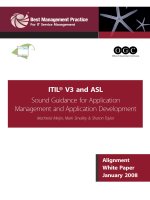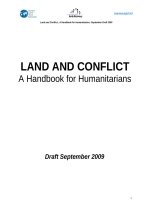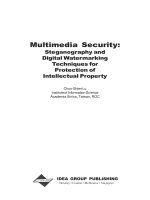Partner selection and job shop scheduling for virtual enterprises
Bạn đang xem bản rút gọn của tài liệu. Xem và tải ngay bản đầy đủ của tài liệu tại đây (1.99 MB, 168 trang )
PartnerSelectionandJobShop
SchedulingforVirtualEnterprises
NIUSIHONG
(B.Eng., Xi’ an Jiaotong University, P.R. China)
A THESIS SUBMITTED
FOR THE DEGREE OF DOCTOR OF PHILOSOPHY
DEPARTMENT OF MECHANICAL ENGINEERING
NATIONAL UNIVERSITY OF SINGAPORE
2011
i
ACKNOWLEDGEMENTS
I would like to express my deep gratitude to my supervisors Prof. Andrew Nee
Yeh Ching and A/Prof. Ong Soh Khim for their guidance and support throughout
my four-year PhD study. It will not be possible to have this thesis without their
unfailing encouragement, useful discussions, constant support, and practical help
to this research project. I am extremely grateful to my supervisors for their
invaluable suggestions during the preparation of this thesis.
I would like to take this opportunity to express my gratitude to my parents and
brothers for their support and encouragement during the course of this study.
There are many challenges, ups and downs in the past four years of studies, no
matter what happens, they are always on the standby and encourage me, comfort
me, for only a call away.
Finally, I would like to thank all who have helped and inspired me during my
doctoral study. I especially want to thank the National University of Singapore for
providing the Research Scholarship for my research, and I am really grateful.
ii
TABLEOFCONTENTS
ACKNOWLEDGEMENTS i
NOMENCLATURE ix
LISTOFABBREVIATIONS xxi
LISTOFTABLES xxiii
LISTOFFIGURES xxiv
Chapter1 Introduction 1
1.1 Partnership Selection in Virtual Enterprises 1
1.2 Scheduling 4
1.2.1 Objectives and Criteria in Scheduling 7
1.2.2 The Complexity of Job Shop Scheduling 9
1.3 Research Motivations and Objectives 10
1.4 Research Goals and Methodologies 11
1.5 Organization of the Thesis 13
Chapter2 An Enhanced Ant Colon y
Optimizer for Multiattribute Partner
iii
SelectioninVirtualEnterprises 15
2.1 Introduction 15
2.2 Literature Review 17
2.3 Partner Selection Formulation 20
2.4 Analysis of Weights of the Criteria and the Qualitative Variables 27
2.4.1 Representation of the Linguistic Terms using Positive Triangular
Fuzzy Numbers 28
2.4.1.1 Representation of Main Criteria 28
2.4.1.2 Evaluation of an Enterprise Against Risk and Reputation 29
2.4.2 Synthetic Evaluation and Defuzzification 31
2.5 An Enhanced ACO Solution Methodology 36
2.5.1 Ant Colony Optimization 36
2.5.2 Enhanced ACO for Partner Selection 38
2.5.3 The Need to Improve ACO 39
2.5.3.1 Fixed Moving Sequence 40
2.5.3.2 Strong Dependence on the Parameters 40
2.5.4 Improvements of ACO 41
2.5.4.1 Generating More Dispersed Solutions 41
2.5.4.2 Modified Scheme for Updating the Trail Intensity 42
2.6 Experiments 43
2.6.1 Parameter Selection 45
2.6.2 First Experiment 46
2.6.3 Second Experiment 55
iv
2.7 Summary 56
Chapter3 An Enhanced IWD
Algorithm for Achieving Optimal
SingleobjectiveJSSPSolutions 57
3.1. Introduction 57
3.2. JSSP Formulation and Representation 60
3.3. Overview of the Original IWD Algorithm 63
3.4. The Enhanced IWD Algorithm, EIWD for JSSP 66
3.4.1 Overview of EIWD Algorithm 66
3.4.2 Schemes for Improving the Original IWD Algorithm 70
3.4.3 Applying the EIWD Algorithm to JSSP 75
3.5 Experimental Evaluation 80
Chapter4 An Enhanced IWD
Algorithm for Achieving Optimal
MultiobjectiveJSSPSolutions 85
4.1 Introduction 85
4.2 Literature Review on the MOJSS Problem 87
4.3 Problem Definition 90
4.4 IWD Algorithm based on Scoring Function 91
v
4.4.1 Disjunctive Graph for MOJSS 92
4.4.2 Overview of the MOJSS-IWD Algorithm 92
4.4.3 Details of the MOJSS-IWD Algorithm 96
4.4.4 Pareto Non-dominated Solution Set Generating Method 102
4.5 Experimental Evaluation and Discussion 102
4.5.1 Experimental Evaluation 102
4.5.2 Discussion 115
4.6 Summary 115
Chapter5 A Multiagent based
Integrated Total Solution (MITS)
Framew ork for the Virtual Enterprise
Environment 117
5.1 Overview of MITS 118
5.2 MITS Level 1: An Agent Service Management Platform for VE 120
5.3 MITS Level 2: Agent-based Approaches for Scheduling 122
5.3.1 Three Types of Multi-agent System Architectures 123
5.3.2 Multi-agent Based Dynamic Scheduling Methodology 124
5.4 MITS Level 3: Internet-based Manufacturing Resource Availability
Monitoring 126
5.5 Discussion 129
5.6 Conclusion 131
vi
Chapter6 Conclusions and
Recommendat ions132
6.1 Research Summary 132
6.2 Contributions 133
6.2.1 A New Approach for Solving Partner Selection Problem in VEs133
6.2.2 Better Understanding and Handling of Partner Selection in VEs133
6.2.3 An Novel Approach for Single Objective JSSP 134
6.2.4 A New Methodology to Solve the Multi-objective JSSP 134
6.2.5 Proposal of a Multi-agent based Integrated Total Solution (MITS)
Framework for Virtual Enterprise Environment 135
6.3 Recommendations 136
6.3.1 Extension of the Enhanced ACO Algorithm to More Complex
Partner Selection Problems 136
6.3.2 Study the Effect of Weights and Different Types of Criteria on the
Partner Selection Results 136
6.3.3 Exploring Efficient and Effective Coding and Decoding
Approaches for JSSP and MOJSSP 137
6.3.4 Implementation and Validation of MITS Concept 137
PublicationsfromthisResearch 138
References 139
vii
ABSTRACT
In today’s global market, it is crucial for enterprises, especially the Small and
Medium-size Enterprises (SME), to form a Virtual Enterprise (VE) focusing their
core competencies and respond better to business opportunities. Partner selection
problem is the key issue related to the success of a VE. Besides, in order to
succeed in the competitive global market, fully utilizing the machining resources
in the enterprise alliance as well as inside the enterprise itself is also essential,
especially as the manufacturing processes become more complex, dynamic and
distributed. Thus, generating effective and efficient schedules definitely has great
significance. Job shop scheduling problems (JSSPs) have been studied extensively
and most instances of JSSP are NP-hard, which implies that there is no
polynomial time algorithm to solve them. As a result, many approximation
methods have been explored to find near-optimal solutions within reasonable
computational efforts.
The developments in optimization methodologies and the behavior of foraging
ants and water drops have inspired the current studies to select the best group of
candidate enterprises to form a VE, as well as generate schedules for both single
optimization objective and multiple optimization objectives to better plan the
resources.
The optimization mechanism for solving the partner selection problem is realized
through the enhancement of an algorithm titled Ant Colony Optimization (ACO).
viii
Experiments have been conducted to evaluate the enhanced ACO algorithm. The
results show that the enhanced ACO algorithm can obtain better results with better
search accuracy and computation time. The enhanced ACO optimization
algorithm can be used as a black box, where the decision maker only needs to
define his/her preference through specifying the search objectives, constraints and
weights to confine the search, and the algorithm can be used to obtain the optimal
set of partners.
The methodology for solving the single objective JSSP and multi-objective JSSP
is achieved through proposing five improvement schemes for a newly developed
meta-heuristic called the Intelligent Water Drops Algorithm (IWD). Experiments
were carried out to identify the effectiveness and efficiency of the modified
algorithm named EIWD. The experimental results show that EIWD can
outperform other approaches for both the single objective JSSP and
multi-objective JSSP.
ix
NOMENCLATURE
List of Symbols for Chapter 1:
n
Number of jobs
m
Number of machines
l
Number of operations
i
J
The i
th
job which will be processed on a set of machines
according to technological constraints and requirements.
ij
O Operation
ij
O refers to the j
th
task of job
i
J to be performed
on a particular machine.
ij
P Processing time
ij
P of an operation
ij
O is the time period
required to process the operation
ij
O
.
i
d Due date
i
d of job
i
J is the time by which this job should be
completed.
i
C The completion time
i
C of job
i
J is the time at which the
last operation of the job
i
J is actually completed.
F
The average flow time of a schedule.
i
F Flow time, it is the amount of time job
i
J spends in the shop
floor
i
r
The job release time
max
C Makespan
max
C the time interval between the time at which
x
the schedule begins and the time at which the schedule ends
w
N
Mean number of jobs waiting for machines
w
N
refers to the
number of jobs waiting in the queue of a resource (machine) or
a work-center.
i
T The tardiness
i
T of a job
i
J is the non-negative amount of
time by which the completion time exceeds the due date d
i
,
max[0,( )]
iii
TCd.
d
i
The due date of job
i
J , it is the time by which this job shold
be completed.
i
T Mean tardiness
i
T is the average tardiness of all the jobs in
the schedule.
T
n Number of tardy jobs
T
n is the number of jobs that are not
completed by their corresponding due dates.
J
Job set { / 1,2 }
i
J
Ji n
M
Machine set
{/ 1,2 }
j
M
Mj m
O
Operation set {/ 1,2 }
k
OOk l
List of Symbols for Chapter 2:
()
t
ij
p
k
Probability for an ant
k
to travel from node i to node j at
th
t
iteration
t
Index of iteration number
xi
P
The entire project
i
p
The
th
i
sub-project,
{1, 2 , . }in
i
ca
The number of candidates bidding for sub-project
i
p
i
NS
Enterprise set formed by candidates bidding for sub-project
i
p
i
r
NS
E
The index represents the
th
r enterprise belonging to an
enterprise set
i
NS
()
t
ij
p
k
The probability for an ant
k
to travel from node i to node j at
th
t
iteration
ij
d
The heuristic distance between nodes i and j
ρ
The evaporation coefficient, which can be a real number
between 0 and 1.0
t
ij
The quantity of pheromone on the edge connecting nodes i and
j at
th
t
iteration
t
ij
Quantity of increased pheromone on the edge connecting
nodes
i and j at
th
t
iteration
()
t
ij
k
The quantity of increased pheromone on the edge connecting
nodes
i
and
j
at
th
t
iteration by the ant
k
Q
A constant representing the total quality of pheromone on a
route
t
Y
The fitness function of the partner selection
The relative importance of the trial,
0
xii
The relative importance of the visibility,
0
The trail persistence,
01
CT
The cost of each candidate enterprise
ij
ct
The cost indicator to choose candidate
j
for sub-project
i
p
O
C
The operational cost of candidate enterprise
D
C
The delivery cost of candidate enterprise
M
C
The material cost of the candidate enterprise
L
C
The logistic overhead of the candidate enterprise
TE
The time related criteria of the candidate enterprise
ij
te
The ‘time’ indicator to choose candidate
j
for sub-project
i
p
du
T
The project duration of the candidate enterprise
s
q
T
The time sequence of the project
de
T
The delivery time of the candidate enterprise
E
D
T
The due date of one sub-project
p
t
T
The processing time of one sub-project in a candidate
enterprise
QT
The quality criterion to optimize
ij
qt
The quality indicator to choose candidate
j
for sub-project
i
p
TL
The technological level of the candidate enterprise
P
F
The performance of the candidate enterprise
xiii
SV
The service level of the candidate enterprise
RK
The risk criterion to optimize
ij
rk
The risk indicator to choose candidate
j
for sub-project
i
p
PS
A fuzzy number representing the political stability of candidate
enterprise
ES
A fuzzy number representing the economy status of the region
of candidate enterprise
FH
A fuzzy number representing the financial health of candidate
enterprise
M
F
A fuzzy number representing the market fluctuations of
candidate enterprise
CP
A fuzzy number representing the competency of candidate
enterprise
RP
The reputation criteria to maximize
ij
rp
The reputation indicator to choose candidate
j
for
sub-project
i
p
PP
A fuzzy number representing the past performance of
candidate enterprise
F
S
A fuzzy number representing the financial status of candidate
enterprise
E
I
A fuzzy number representing the image of the enterprise of
candidate enterprise
CH
A fuzzy number representing the cooperation history of the
xiv
candidates and the dominant enterprise
i
st
The actual start time of sub-project
i
p
ST
The planned start time of the entire project
i
ed
The end time of sub-project
i
p
ED
The planned end time of the entire project
i
CST
The start time the candidate offers for sub-project
i
p
i
CED
The end time the candidate offers for sub-project
i
p
l
os
The
th
l object in the object set OS
o
The total number of objects in the object set OS
k
gs
The
th
k goal in the goal set GS
g
The total number of goals in the goal set
GS
,lk
N
The evaluation value of the
th
l object for the
th
k goal
()
M
x
The membership function carries fuzzy set
M
into [0,1]
(0,1)U
The uniformly distributed pseudo-random numbers which
values are between 0 and 1
List of Symbols for Chapter 3:
n
Number of jobs
m
Number of machines
l
Number of operations
dis
G
Disjunctive graph for JSSP schedule
xv
N
Node set in
dis
G
C
Conjunctive arc set in
dis
G
D
Disjunctive arc set in
dis
G
IWD
N
Number of IWDs
_
I
WD iter
N
Number of iterations in algorithm EIWD
elite
N
Number of elite IWDs (used in scheme 4)
IWD
i
p
j
Probability of choosing node j among node i’s adjacent nodes
in disjunctive graph
dec
Random number used for choosing
IWD
i
p
j computation
method
0
Threshold used to compare with
dec
in choosing
IWD
i
p
j
computation method
Coefficient to represent relative importance of the soil to the
processing time of the next operation
,
s
oil i j
Soil on edge (i,j)
,
g
I
WD
IWD
s
s
oiloil
Soil of g-th IWD, soil of an IWD
IWD
k
soil
Soil of k-th IWD in the elite group carries (used in scheme 4)
k
elite
S
Corresponding schedule of the k-th IWD in the elite group
(used in scheme 4)
,,
vvv
abc
IWD velocity updating parameters
,,
s
ss
abc
IWD soil updating parameters
f(soil(i,j))
Function used in the computation of
IWD
i
p
j
xvi
p
t
(j) Processing time of operation j
g(soil(i,j))
Function used in the computation of
IWD
i
p
j
s
A control parameter used in f(soil(i,j))
v
A control parameter used in computing travelling time of an
IWD along an edge
L
Local soil updating parameter
(, )soil i j
The soil an IWD loads from edge (i,j), also known as soil
changes
min
soil
Lower bound for soil changes in any edge (i,j)
max
soil
Upper bound for soil changes in any edge (i,j)
IWD
Global soil updating parameter
I
B
S
Iteration best schedule
TB
S
Total (global) best schedule
% of elite IWDs in all IWDs (used in scheme 4)
% of random IWDs chosen for local search in all IWDs (used
in scheme 5)
'
dec
Random number used for choosing IWDs for local search
0
'
Threshold used choosing IWDs for local search
'
Breadth
N
Number of neighbors (schedules) generated in a single round
of breadth-first local search
'
D
epth
N
Number of rounds of breadth-first search in depth-first local
search
xvii
A
IWD group
g
I
WD
g-th IWD
g
IWD
vel
Velocity of
g
I
WD
q(s)
Quality(makespan) of a schedule s
BD
S
Best solution group used in combined local search (in scheme
5)
BD
N
Number of best solutions in group
BD
S (in scheme 5)
x
s
A solution in
BD
S
rn
Random number
List of Symbols for Chapter 4:
N
Number of jobs
M
Number of machines
L
Number of operations
dis
G
Disjunctive graph for JSSP schedule
N
Node set in
dis
G
C
Conjunctive arc set in
dis
G
D
Disjunctive arc set in
dis
G
I
WD
N
Number of IWDs
_IWD iter
N
Number of iterations in algorithm MOJSS-IWD
elite
N
Number of elite IWDs
xviii
IWD
i
pj
Probability of choosing node j among node i’s adjacent
nodes in disjunctive graph
dec
Random number used for choosing
IWD
i
p
j
computation method
0
Threshold used to compare with
dec
in choosing
IWD
i
p
j computation method
Coefficient to represent relative importance of the soil to
the processing time of the next operation
,
s
oil i
j
Soil on edge (i,j)
,
g
I
WD
IWD
s
s
oiloil
Soil of g-th IWD, soil of an IWD
IWD
k
soil
The soil k-th IWD in the elite group carries
k
elite
S
Corresponding schedule of the k-th IWD in the elite group
v
a
,
v
b
,
v
c
IWD velocity updating parameters
s
a
,
s
b
,
s
c
IWD soil updating parameters
,
f
soil i
j
Function used in the computation of
IWD
i
p
j
p
t
(j) Processing time of operation j
g(soil(i,j))
Function used in the computation of
IWD
i
p
j
s
A control parameter used in f(soil(i,j))
v
A control parameter used in computing travelling time of
an IWD along an edge
L
Local soil updating parameter
xix
(, )soil i j
The soil an IWD loads from edge (i,j), also known as soil
changes
min
soil
Lower bound for soil changes in any edge (i,j)
max
soil
Upper bound for soil changes in any edge (i,j)
I
WD
Global soil updating parameter
IB
S
The best schedule in an iteration
TB
S
Total (global) best schedule
% of elite IWDs in all IWDs
% of random IWDs chosen for local search in all IWDs
'
dec
Random number used for choosing IWDs for local search
0
'
Threshold used choosing IWDs for local search
'
B
readth
N
Number of neighbours (schedules) generated in a single
round of breadth local search
'
D
epth
N
Number of rounds of breadth search in depth local search
A
IWD group
g
I
WD
g-th IWD
g
I
WD
vel
Velocity of
g
I
WD
q(s)
Quality (makespan) of a schedule s
B
D
S
Best solution group used in the combined local search (in
scheme 5)
B
D
N
Number of best solutions in group
B
D
S
xx
x
s
A solution in
B
D
S
xxi
LISTOFABBREVIATIONS
List of abbreviations for Chapter 1
SME Small and Medium-size Enterprise
VE Virtual Enterprise
TP
Throughput
WIP Work-In-Process
ACO Ant Colony Optimizer
IWD Intelligent Water Drops algorithm
EIWD Enhanced IWD Algorithm
MOJSS Multi-Objective Job Shop Scheduling
List of abbreviations for Chapter 2
MADM Multi-Attributive Decision Making
ANP Analytical Network Process
AHP Analytical Hierarchy Process
TOPSIS Technique for Order Preference by Similarity to Ideal Solution
GA Genetic Algorithms
PSO Particle Swarm Optimization
TA Tabu Search
AI Artificial Intelligence
TFN Triangular Fuzzy Number
xxii
PTFN Positive Triangular Fuzzy Number
AS Ant System
NC Number of Cycles
List of abbreviations for Chapter 3
JSSP Job Shop Scheduling Problem
SA Simulated Annealing
SB
Shifting Bottleneck
TSP Travelling Salesman Problem
BKS Best Known Solutions
List of abbreviations for Chapter 4
MOJSSP Multi-Objective Job Shop Scheduling Problem
List of abbreviations for Chapter 5
OMA Overall Monitoring Agent
JSA Job Shop Agent
JA Job Agent
MA
Machine Agent
xxiii
LISTOFTABLES
Table 2.1 Importance/preference of one criterion over another (Chan et al. 2008)
29
Table 2.2 Triangular fuzzy conversion scale 31
Table 2.3 Linguistic expressions of sub-criteria of risk with respect to each other
35
Table 2.4 C matrix of the sub-criteria of risk with respect to each other 35
Table 2.5 The linguistic evaluation of the candidates bidding for project
1
p
based on sub-criteria of
R
K 36
Table 2.6 The fuzzy representation of the candidates bidding for project
1
p
based on sub-criteria of
R
K
36
Table 2.7 The parameters in the enhanced ACO algorithm 46
Table 3.1 The processing time (in unit time) for each operation (3×3 job) 62
Table 3.2 The machine to process each operation (3×3 job) 62
Table 3.3 Parameters in the experiments 81
Table 3.4 Computational results of FT and LA test instances 82
Table 3.5 Computational results of FT and LA test instances 82
Table 3.6 Computational times of EIWD for the FT and LA instances 84
Table 4.1 Parameters in the experiments 103
Table 4.2 Computational results of FT test instances (FT06, FT10, FT20) 106
Table 4.3 Computational results of LA test instances (LA01-LA08) 107
Table 4.4 Computational results of LA test instances (LA09-LA16) 108
Table 4.5 Computational results of LA test instances (LA17-LA24) 109
Table 4.6 Computational results of LA test instances (LA25-LA32) 111
Table 4.7 Computational results of LA test instances (LA33-LA40) 112
Table 4.8 Computational results of FT and LA test instances 113
Table 5.1 Comparison of the hierarchical, heterarchical and hybrid control
frameworks 124
Table 5.2 Functions of each agent in member enterprise 127
xxiv
LISTOFFIGURES
Figure 1.1 The structure of the enterprises in a VE 4
Figure 1.2 Schematics of a job shop (Chryssolouris 2006) 6
Figure 2.1 n enterprise sets for n sub-projects 21
Figure 2.2 The five main criteria and their corresponding sub-criteria 22
Figure 2.3 Triangular fuzzy number representation of the relative importance of
the criteria (Chan
et al. 2008) 29
Figure 2.4 The linguistic scale of the triangular numbers 31
Figure 2.5 The experimental procedure 44
Figure 2.6 Performance of the original ACO (5 ants, 130 candidates) 48
Figure 2.7 Performance of the original ACO (10 ants, 130 candidates) 48
Figure 2.8 Performance of the enhanced ACO (10 ants, 130 candidates) 49
Figure 2.9 Performance of the enhanced ACO (10 ants, 130 candidates) 50
Figure 2.10 Performance of the original ACO (20 ants, 130 candidates) 51
Figure 2.11 Performance of the enhanced ACO (20 ants, 130 candidates) 52
Figure 2.12 Performance of the original ACO (30 ants, 130 candidates ) 53
Figure 2.13 Performance of enhanced ACO (30 ants, 130 candidates ) 54
Figure 2.14 Effect of number of ants on the convergence speed (130 candidates)54
Figure 2.15 Effect of number of candidates on the convergence speed (20 ants) 55
Figure 3.1 Disjunctive graph for the 3×3 job described in Table 3.1 and Table 3.2
63
Figure 3.2 Modified disjunctive graph for the 3×3 job in Table 3.1 and Table 3.2
76
Figure 3.3 Modified disjunctive graph for the 3×3 job in Table 3.1 and Table 3.2
(dash edges for
22
O ) 77
Figure 3.4 Flow chart of EIWD algorithm for JSSP 79
Figure 4.1 Flowchart of the MOJSS-IWD algorithm 95
Figure 5.1 The three-level design of dynamic scheduling system for a VE 119
Figure 5.2 The service management platform for a VE 121
Figure 5.3 The events sequence of agent service management platform 122
Figure 5.4 Relationships among different types of components in the scheduling
system 125
Figure 5.5 The machine resource repository 128









